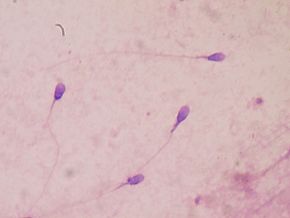
Oh no... Back in 2017 a large study found that male sperm counts had dropped over 50% since the 1970s in North America, Europe, and Australia. Declining every year, year after year, for over 40 years. This has serious implications for fertility - if sperm counts drop too low, it's very difficult to conceive a baby.
Now those same researchers have published data from 53 countries showing that the sperm count decline is also occurring in Asia, South America, and Africa. And that the decline in male sperm counts is actually accelerating in North America and Europe. Yikes!
Note that this is in men who weren't being screened for fertility problems issues. In other words, random healthy men. Some had already fathered a baby.
Globally, the decline was about 1.16% per year from 1973 to 2018 (resulting in a 52% decline). When the researchers reexamined the data and looked at many more studies, they realized that since 2000 the decline accelerated at 2.64% per year.
Average global sperm concentration was 49 million per milliliter of semen in 2018. The researcher Dr. Swan pointed out that when sperm count drops below roughly 45 million per milliliter, the ability to cause a pregnancy begins to plummet dramatically, and at 40 million and lower the chances of conception are very low without reproductive assistance (e.g., IVF).
Interestingly, sperm counts are not just a male fertility issue, but also an indicator of men's health. Low levels of sperm are associated with increased risk of chronic disease, testicular cancer, and a shorter lifespan. With a decline in sperm numbers there is also a decline in testosterone and male genital anomalies - thus a decline in male reproductive health.
Why is this happening? Several possibilities are probably contributing: mainly lifestyle and also all the chemicals and plastics in our lives (environmental chemical exposure). Endocrine disruptors, phthalates, pesticides! Yes, they are all around us - in the air, the water, consumer products, and our bodies.
Some examples: pesticides, flame retardants, stain and water resistant products. Plastics leach and outgas and we get them into us various ways (skin, inhale them, ingest them in our foods and water). List of ways to reduce exposure to harmful chemicals.
THINGS YOU CAN DO TO IMPROVE SPERM COUNT AND HEALTH:
Lifestyle: Don't smoke. Don't drink or drink very little. Don't do drugs. Don't sit in hot tubs or saunas. Get exercise or physical activity. Eat a diet rich in fruits, vegetables, whole grains, legumes, seeds, nuts. Avoid canned foods, minimize fast food take-out. Eat as much organic as possible. Lose weight, if needed.
Chemical exposure: We can't totally avoid all the chemicals, but we can minimize our exposure. For starters, stop using non-stick cookware, avoid pesticides in the home and yard (look for nontoxic alternatives and view weeds as wildflowers), don't use dryer sheets, buy unscented products (and avoid fragrances). List of ways to reduce exposure to harmful chemicals.
From Science Daily: Significant decline in sperm counts globally, including Latin America, Asia and Africa, follow-up study shows
An international team led by Professor Hagai Levine of Hebrew University of Jerusalem's Hadassah Braun School of Public Health, with Prof. Shanna Swan at the Icahn School of Medicine, Mount Sinai, New York, along with researchers in Denmark, Brazil, Spain, Israel and the USA, published the first meta-analysis to demonstrate declining sperm counts among men from South and Central America, Asia and Africa.
Alarmingly, this study also shows that the decline in sperm counts in North America, Europe, and Australia -- reported by this team in 2017 -- has continued and even accelerated in the 21st century. Sperm count is not only an indicator of human fertility; it also is an indicator of men's health, with low levels being associated with increased risk of chronic disease, testicular cancer and a decreased lifespan. The authors say the decline reflects a global crisis related to our modern environment and lifestyle, with broad implications for the survival of the human species.
This latest analysis, with data from 53 countries, was published today in the journal Human Reproduction Update. It includes an additional seven years of data collection (2011-2018) and focuses on sperm count trends among men in regions not reviewed previously, specifically South America, Asia and Africa. The data shows, for the first time, that men in those regions share the significant decline in total sperm counts (TSC) and sperm concentration (SC) seen previously in North America, Europe and Australia. Furthermore, this study shows an accelerated post-2000 decline in TSC and SC globally. As Levine summarized these results, "Overall, we're seeing a significant worldwide decline in sperm counts of over 50% in the past 46 years, a decline that has accelerated in recent years."
While the current study did not examine the causes of sperm count declines, Levine pointed to recent research indicating that disturbances in the development of the reproductive tract during fetal life are linked to lifetime impairment of fertility and other markers of reproductive dysfunction. Additionally, Levine explained that "lifestyle choices and chemicals in the environment are adversely affecting this fetal development."
Time is running out, cautioned Levine. "Our findings serve as a canary in a coal mine. We have a serious problem on our hands that, if not mitigated, could threaten humankind's survival. We urgently call for global action to promoted healthier environments for all species and reduce exposures and behaviors that threaten our reproductive health."
Swan stressed that low sperm counts do not only affect men's fertility, but have serious ramifications for men's health more generally, and are linked with other adverse trends, termed together as testicular dysgenesis syndrome. "The troubling declines in men's sperm concentration and total sperm counts at over 1% each year as reported in our paper are consistent with adverse trends in other men's health outcomes, such as testicular cancer, hormonal disruption, and genital birth defects, as well as declines in female reproductive health. This clearly cannot continue unchecked."
